“How do they feel?” asked my grandmother, as she watched me march the length of the climbing shop.
“Fine,” I grunted monosyllabically. I was only 12 years old.
Granny nodded. “We’ll have these,” she declared to the shop assistant and pointed at the leather walking boots that were weighing down my feet. “They’ll last forever and will see him out.”
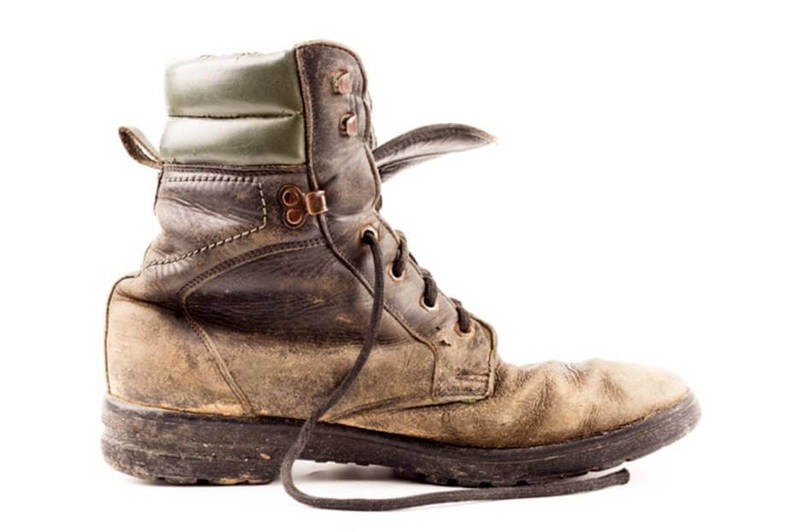 Granny was wrong, as my feet grew, the boots leaked and were soon replaced by others. Yet that was the understanding of the era. Walking boots would last for life and be with you to the end.
Granny was wrong, as my feet grew, the boots leaked and were soon replaced by others. Yet that was the understanding of the era. Walking boots would last for life and be with you to the end.
I now know differently. Granny’s shopping was followed by a lifetime of poor footwear, including a spell in the British Army, which seemed to feel that all feet were identical. One look at my shoe cupboard and a disorganised pile of mountaineering footwear falls out. Boots, trainers, approach shoes, even mountain sandals. My favourites are the trainers, as they are lightweight, should not leak but do, and carry the Quicklace system, which saves me tying a bow. One tug with ice-cold hands and the trainer is secure.
For a day’s walking in the mountains, especially when carrying a rucksack, my trainers struggle. Should that happen, on go my boots. I try to be lightweight, which means synthetic, as leather is generally heavy. Lightweights can wear out quickly, so I buy a new pair each year.
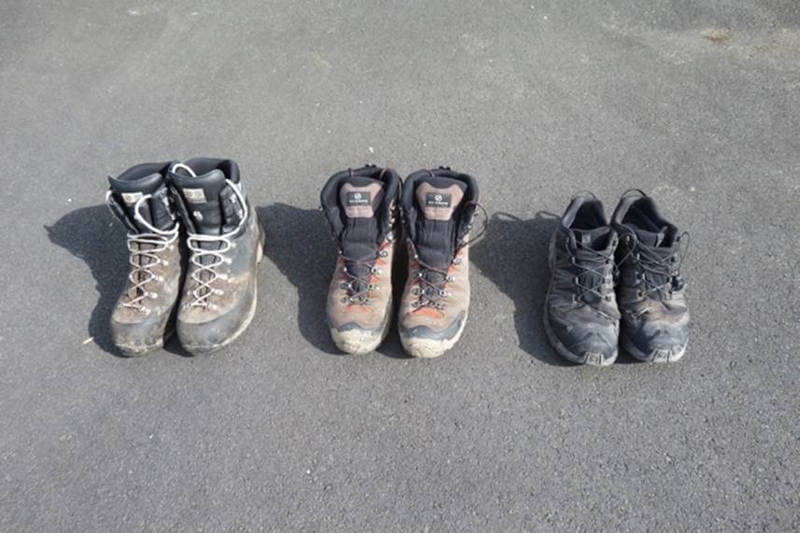 Be warned that lightweights can pong. I once spent six weeks crossing the Alps, from Geneva to the Mediterranean, and slept in many cramped mountain refuges. Walkers were usually on bunks. One night it happened.
Be warned that lightweights can pong. I once spent six weeks crossing the Alps, from Geneva to the Mediterranean, and slept in many cramped mountain refuges. Walkers were usually on bunks. One night it happened.
“What is that terrible smell?” I heard a Frenchman say to his colleague. They were in a far corner of our crowded dormitory.
“Disgusting,” the colleague replied.
“Ugh!” exclaimed another.
“I’m going to be sick,” said a fourth, and headed for the door.
I lay in silence, feeling guilty. The smell was my lightweights, positioned under my bunk. You make no friends going lightweight, especially in a refuge.
The weight of footwear is important, as mountain lore has long declared that one pound on the feet is five pounds on the back. My two mountain trainers weigh 1.8 pounds (0.82 kg) and I barely realise they are on. My winter boots, with crampons, weigh 10 pounds (4.5 kg), a fifty-pound rucksack on my feet. I try to stay light.
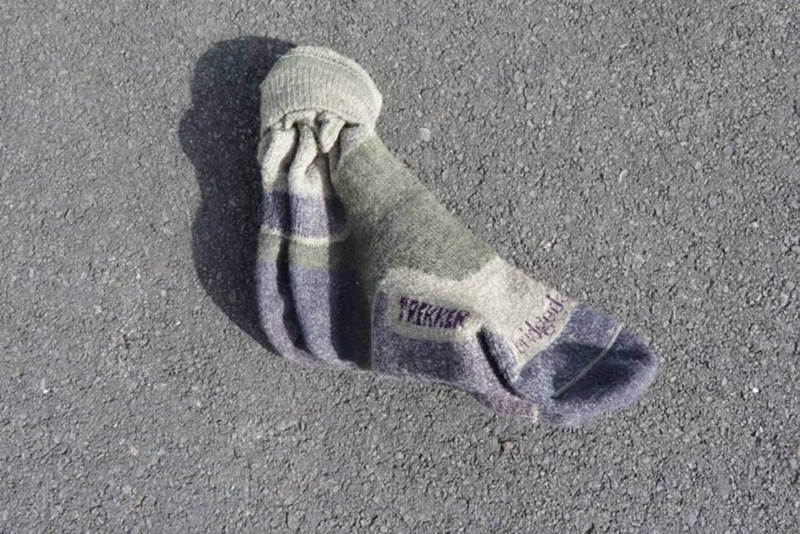 There are no shortcuts when buying new boots, as a wrong fitting can be ruinous. The secret is not the boot, but the sock. I spend as long choosing the one as the other. My socks are woollen for sure, merino especially, with something man-made thrown in. This gives socks strength, allows them to stretch, as well as survive a washing machine.
There are no shortcuts when buying new boots, as a wrong fitting can be ruinous. The secret is not the boot, but the sock. I spend as long choosing the one as the other. My socks are woollen for sure, merino especially, with something man-made thrown in. This gives socks strength, allows them to stretch, as well as survive a washing machine.
Socks chosen, next the boots. I buy them in the afternoon, when my feet will be bigger, and I do not do a last-minute dash the day before a holiday. I know what design I seek before I enter the shop, and I choose an assistant who understands mountains.
For most, a boot should be flexible but not too bendy. If I seek full bend, I choose a trainer. I like a rand that covers the toe, while for the sole, Vibram is my favourite. This was named after Vitale Bramani who, in 1935, saw six of his friends slip to their deaths in the Alps, thanks to leather soles and hobnails. Bramani set to work and soon patented the sole now used worldwide. I go nowhere without Vibram.
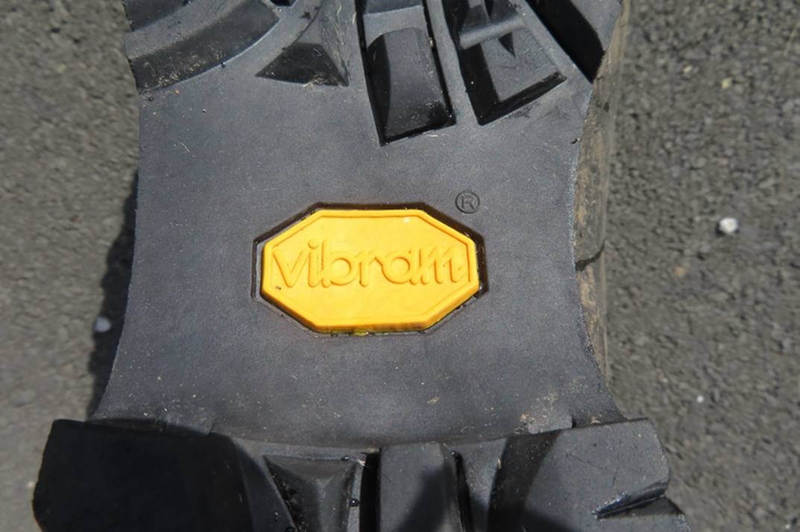 Then comes the fitting, but I do not put on the boot. I remove the insole, lay it on the floor, and stand on it. I can instantly see if the boot might fit. I keep a forefinger’s width between the tip of my longest toe and the front of the insole, in case my foot slips forward when descending.
Then comes the fitting, but I do not put on the boot. I remove the insole, lay it on the floor, and stand on it. I can instantly see if the boot might fit. I keep a forefinger’s width between the tip of my longest toe and the front of the insole, in case my foot slips forward when descending.
Then it is time for the boots. Back go the insoles, in go my feet, and the laces are tied in a jiffy. If it is fine, that is good. If not, no worries. I keep trying until I am happy. Next stop the mountains.
However, perfect my boots, I still think blisters. At the end of a long march in the Army, we would be stood barefoot and to attention, ready for inspection. Anyone with a blister was punished.
Thanks to that experience, and before I pull on a sock, I coat a whisker of petroleum jelly on my foot. I then slither on the sock, wool on jelly, next the boot, tie the laces, and I’m done. Since jelly, I have never had a blister.
Thank you, Granny, for buying me those boots. Over decades, I have learned plenty.
If you want to buy walking boots
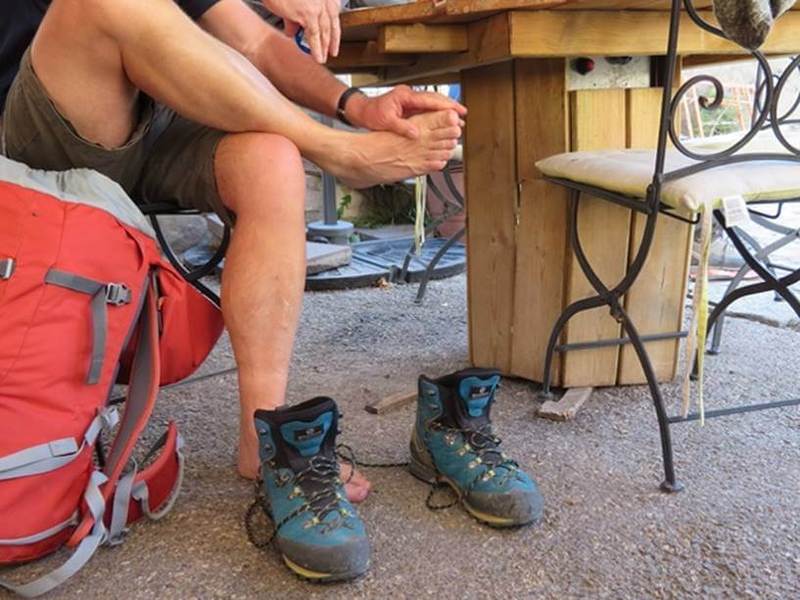 Walking boots are widely available, and you are spoiled for choice should you wish to buy any, so prepare to be confused. Whatever they tell you, do not expect them to last forever. I work on 1000 miles of walking before I need a new pair. Some are expensive, some are cheaper, and you do not always get what you pay for.
Walking boots are widely available, and you are spoiled for choice should you wish to buy any, so prepare to be confused. Whatever they tell you, do not expect them to last forever. I work on 1000 miles of walking before I need a new pair. Some are expensive, some are cheaper, and you do not always get what you pay for.
Some reputable brands include:
Scarpa
Salomon
Meindl
Hanwag
Haglöfs
Merrell
I wear Salomon Men’s XA Pro 3D V8 GTX trail running shoes for daily exercise on my nearby fells. They are comfortable, but started crumbling less than two months after purchase, although I do spend a lot of time in the mountains.
When I crossed the Alps, I wore Scarpa R-Evo GTX boots. They were brilliant but did stink out the mountain refuges.
An icon of walking for over three decades is the Scarpa Manta. I have a pair. They are fantastic but slightly heavy by modern standards.
My favourite shops for walking boots are:
Cotswold Outdoor
Cunningham
Ellis Brigham
16 steps to boot-buying
- Take your time – buying walking boots is not a rushed process.
- Try the boots on in the afternoon, when your feet may be slightly swollen.
- Do not buy new boots the day before a walk.
- Start by choosing the sock, one pair only. Bring your own, not one offered by the shop.
- Decide if you want trainers, walking shoes, walking boots, or something for snow and ice. Most seek walking boots, especially if a rucksack is involved, or trainers if they are athletic.
- Ignore the question a shop assistant may ask, “Where are you going walking?” All walks are varied, and it is impossible to generalise.
- Lightweight or leather? Lightweight is normally synthetic, leather is heavier.
- How flexible is it? There is a B-rating of boots. B0 (fully flexible) or B1 are right for most. Try B2 or B3 (stiff as a board), if you wish to fit a crampon.
- Waterproof? Mine are. Think Gore-Tex.
- What type of sole? I am a fan of Vibram, which is used the world over.
- Be sure there is a rand, in case you stub your toe.
- Do they fit? Take out the insole and place it on the floor. Put your foot on the insole and assess the fit. You need a single finger’s breadth between the tip of your longest toe and the front of the insole.
- Replace the insole, try on the boot, and lace it up. Check the tongue does not press uncomfortably on the top of your foot.
- Walk up and down a slope to see how the boot feels.
- Try the boot at home but stick to carpet in case you need to return the boot.
- If all is well, next stop are the mountains.
More information
Top tips for choosing the perfect boot
Which walking boots are right for you?











